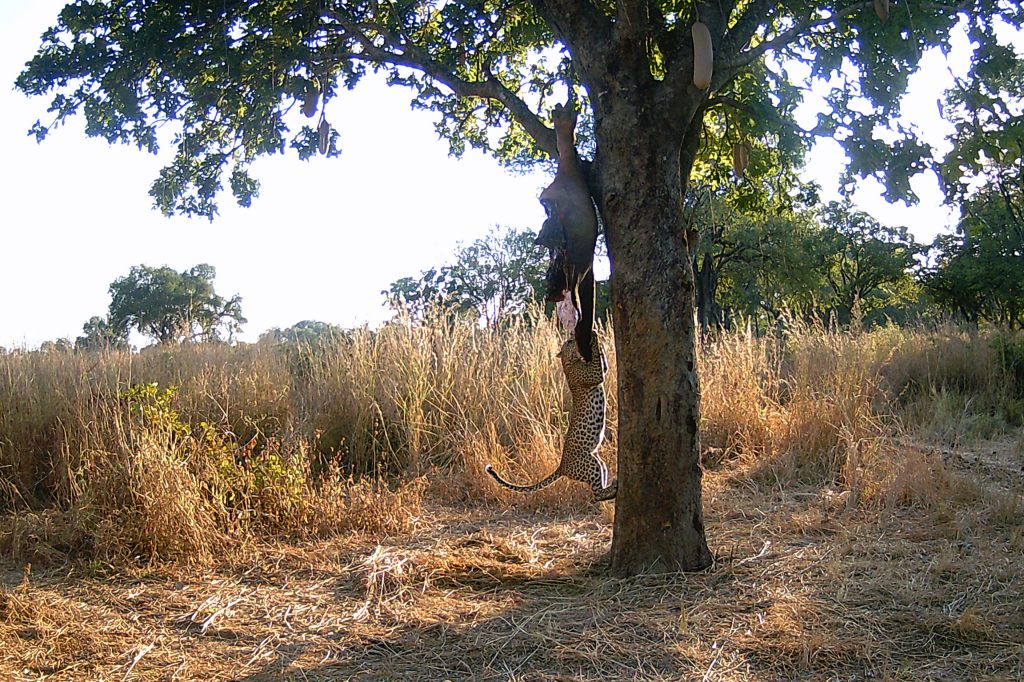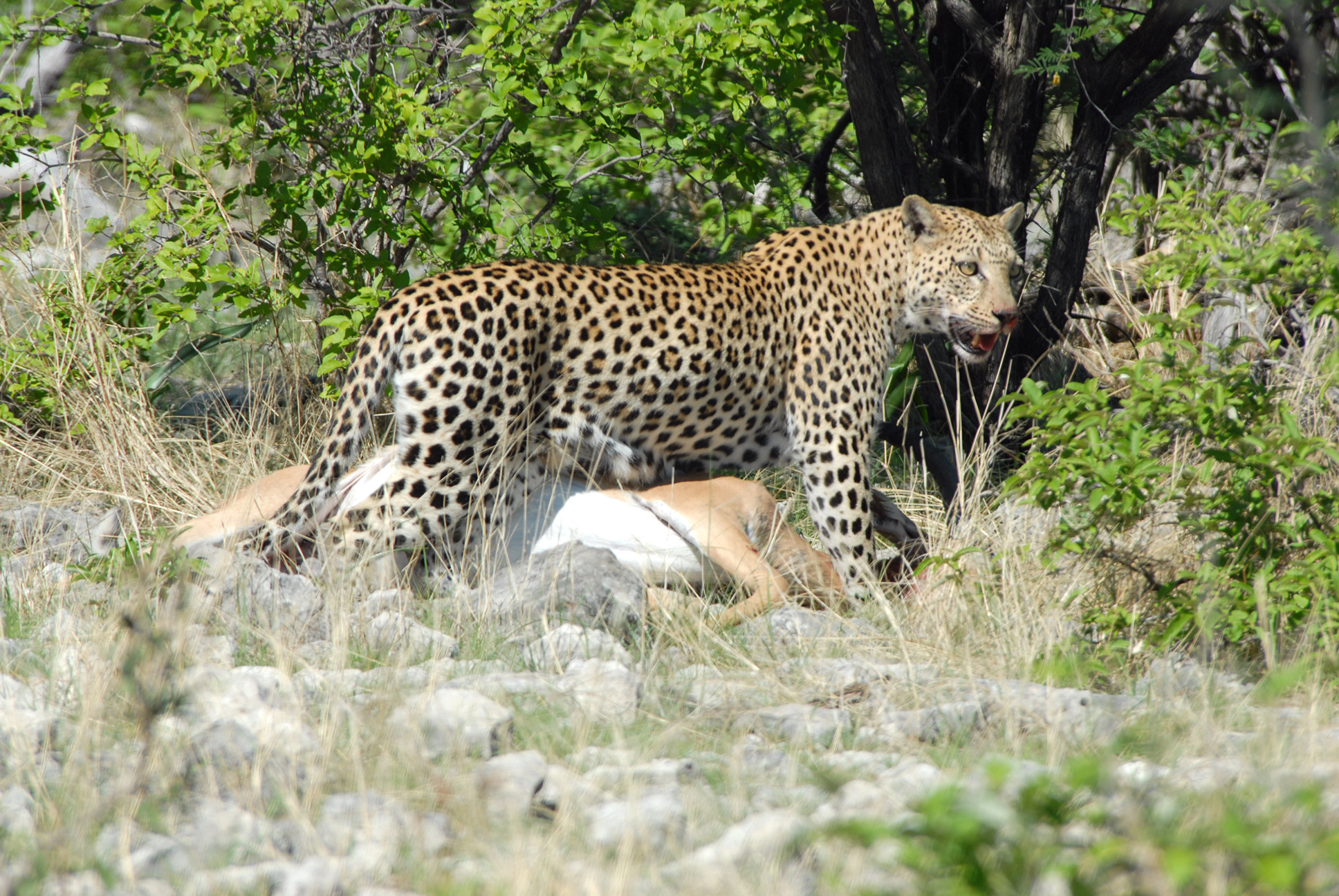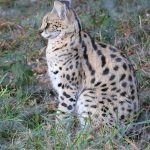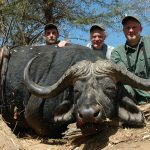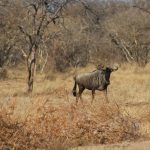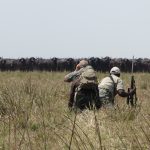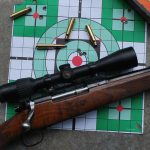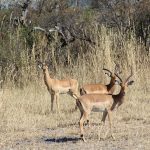How to make sure your leopard is “dead under the tree.”
Photo above courtesy of Dirk de Bod
Authorities with greater experience have judged the leopard Africa’s most dangerous animal. I do not agree. With modern medicine, a human is likely to survive a leopard mauling. However, the leopard is the most likely of Africa’s dangerous game to hurt you. Usually, this happens because the first shot is not perfectly placed. If it isn’t, things get scary!
I estimate around a thousand leopards are taken annually by safari hunters, and many more by farmers protecting their livestock. In some areas, leopards are still taken with dogs. A chance encounter is uncommon today because most licenses specify “males only.” This means a leopard must be accurately judged before that critical first shot is fired.
Although unpopular today, I support hound hunting because it is the most selective technique. There are at least two opportunities to properly judge the leopard: When the spoor is found, and when the leopard is bayed or treed. Doesn’t much matter what I think; hound hunting remains legal in few areas. Continent-wide, most leopards are taken over bait.
Over bait, the light may be terrible, but the shot will be close, and usually from a good rest. It should be easy, but until you’ve been there it’s hard to imagine the adrenaline rush when a leopard materializes on your bait. Actual misses are rare, but an inordinate number of leopards are wounded, and that’s when trouble starts. I’ve done it. Not good!
When the PH gives the “go-ahead,” your job is to kill the leopard. Unlike many situations with dangerous game, there is almost never a chance for a second shot. You will be jarred by the crash and recoil, perhaps blinded by the flash. On leopard, the shooter rarely knows exactly what happened next.
Heartbeats after the shot, you want to hear a sodden thump, like a bag of wet cement dropped from a building. That usually means the leopard is dead under the tree, the most desirable outcome. Or so I’m told, because I’ve never heard that sound. I’ve taken a half-dozen and witnessed many others. One of mine was poorly hit and recovered in a charge. I don’t want to do that again!
Most of my leopards were well-hit and recovered after brief follow-ups. Except for the fear, this is common with most game animals taken. Absent brain or spine shots, it’s unusual for any game animal to drop in its tracks and stay down. Leopards are no different. Except, with a leopard, you want the cat to be dead under the tree. The follow-up is much different from tracking a whitetail.
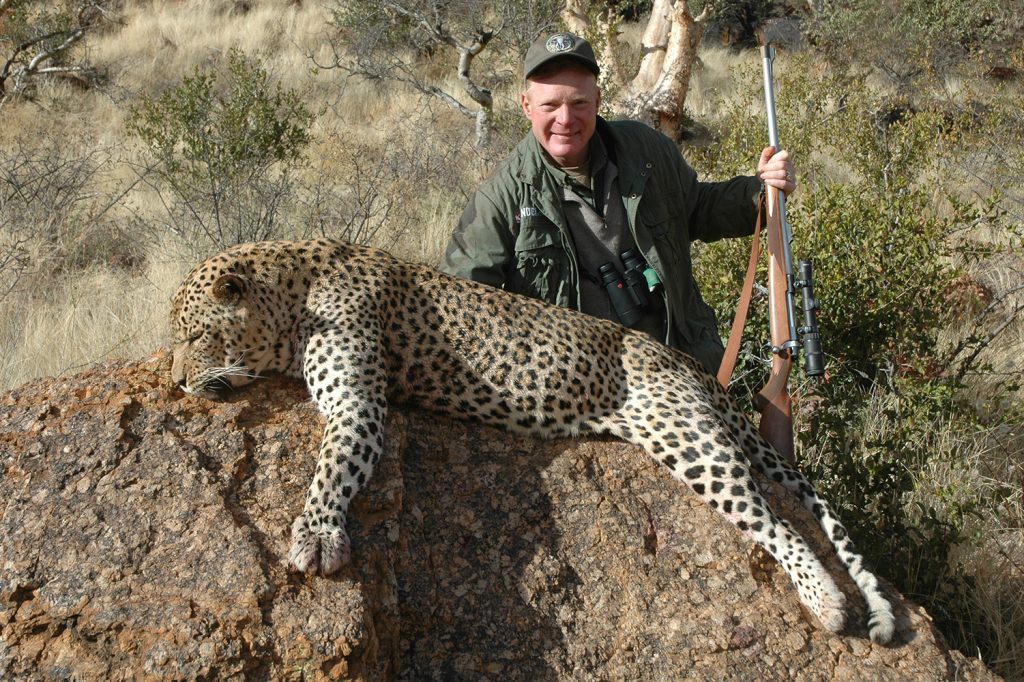
A leopard is almost always keyed up, on full alert. The fact that most baits are hung in trees is also a factor. Up in a bait tree, it will usually depart with a mighty leap, if it can. It’s never a good sign if the leopard exits the tree under its own power. This is not definitive; just not what you hope for. In 2007 I shot a leopard in Namibia’s Bushmanland with Jamy Traut. Shooting a Kimber .375, I was confident of the shot on the center of the shoulder. However, the last thing I saw was the cat exiting the scope’s field of view, left and high. We found him dead forty yards into the long grass.
This past July, son-in-law Brad Jannenga shot a nice leopard in Zambia, also with a .375. I was in the blind with a video camera. It was almost déjà vu; the cat exited high and left. Brad was sure of the shot. PH Davon Goldstone and I weren’t because the presentation was odd, the bottom of the chest almost facing us as he crouched over the bait.
Video cameras are useful with leopards; a quick playback can show shot placement. This time, with deep shadow, even with the camera we weren’t certain, but it was clear the cat had launched into tall grass. So, with light fading, we organized and went into that nasty stuff. The cat, hit perfectly and very dead, was nearly invisible until we almost stepped on him.
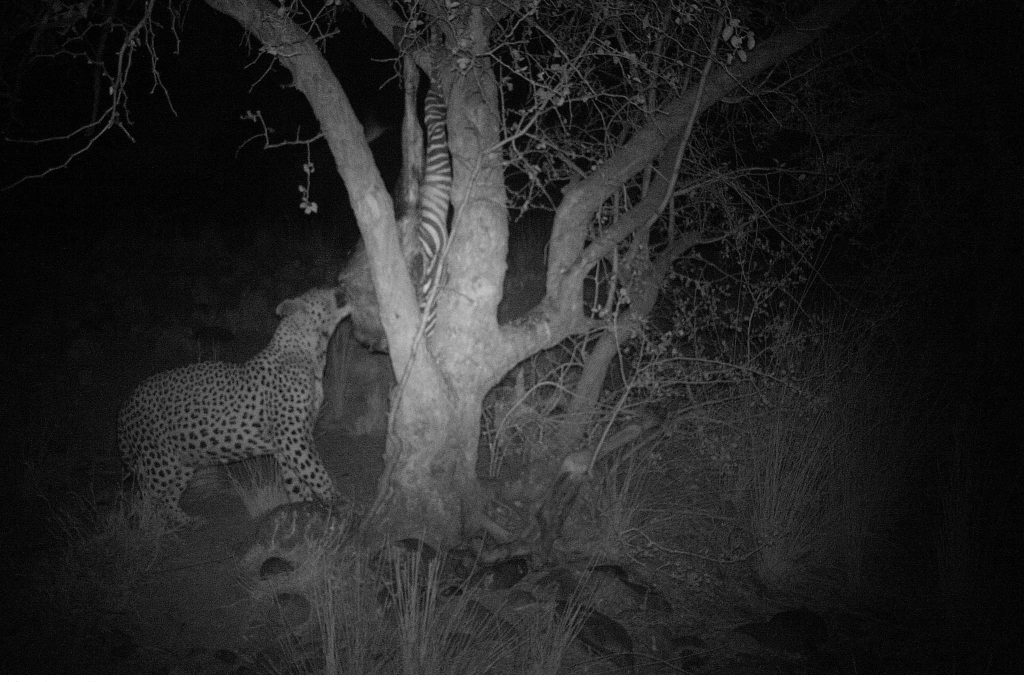
In a perfect world, you want a nice, broadside presentation. Shot placement on a leopard is no different from anything else: about one-third up from the brisket/belly line on the center of the shoulder. Or, alternatively, just behind the shoulder, following the rear line of the foreleg, no more than halfway up. The latter is a fatal lung shot, but unlikely to drop your big tom “under the tree.” Like most lung-shot animals, a leopard will run a short distance, but no animal can survive a double-lung shot.
I believe the shoulder shot is the most likely to fold a leopard on the spot. Such a shot will surely break the near shoulder and, if the leopard is truly broadside, will penetrate through the chest cavity and break the far shoulder.
When setting a bait, effort is made to orchestrate that broadside shot. Despite good intentions, this doesn’t always work! In poor light, slight angles are hard to see, and leopards get into weird positions when feeding. Brad’s Zambian leopard was a good example. Essential is to be able to visualize exactly where the chest cavity lies.
With cats, the heart is slightly farther forward in the chest cavity than with ungulates. A bullet through the center of the shoulder, one-third up, will catch the top of the heart. However, when feeding on a hanging bait, a leopard will often use out-stretched paws. This changes the game, and the center of the shoulder may be too far forward. If in doubt, the behind-the-shoulder lung shot is safe, and offers the largest target. Just expect a short period (several eternities) of tense tracking.
What you hit the leopard with matters. In some countries, the dangerous game minimum, .375 or 9.3mm, applies. Game laws must be obeyed, but I am convinced the .375, or any other cartridge suitable for thick-skinned dangerous game, is a poor choice. Cats are tenacious, but the biggest leopard is smaller than a mule deer buck. You don’t need cartridges (or bullets) designed for animals ten times bigger. Nor do you need the low magnification, straight objective scopes that are great for hunting Cape buffalo.
For the quickest results on leopards, I’m convinced you’re better served with cartridges and bullets intended for optimum performance on deer-sized animals. My central-shoulder shot placement on that Namibian leopard, taken with a .375, was perfect. He didn’t go far, but we had bad moments in long grass, light going fast. There’s no way to know, but I will always believe that was my chance to have a leopard “dead under the tree,” and I think it would have happened if I’d made the same shot with a deer cartridge with a lighter, faster, quicker-expanding bullet.
That same season, hunting with Dirk de Bod, Donna took a leopard with a Ruger .30-06, 180-grain Hornady Interlock. Hers was dead under the tree. Maybe she just shot it better, but I believe her .30-06 was a better choice. I also used a .30-06 on a Zambezi Valley leopard. But, with light going fast, I went for the lung shot, larger target, thus safer. The follow-up was done in full darkness, terrifying, but the leopard was dead within seconds of exiting the tree.
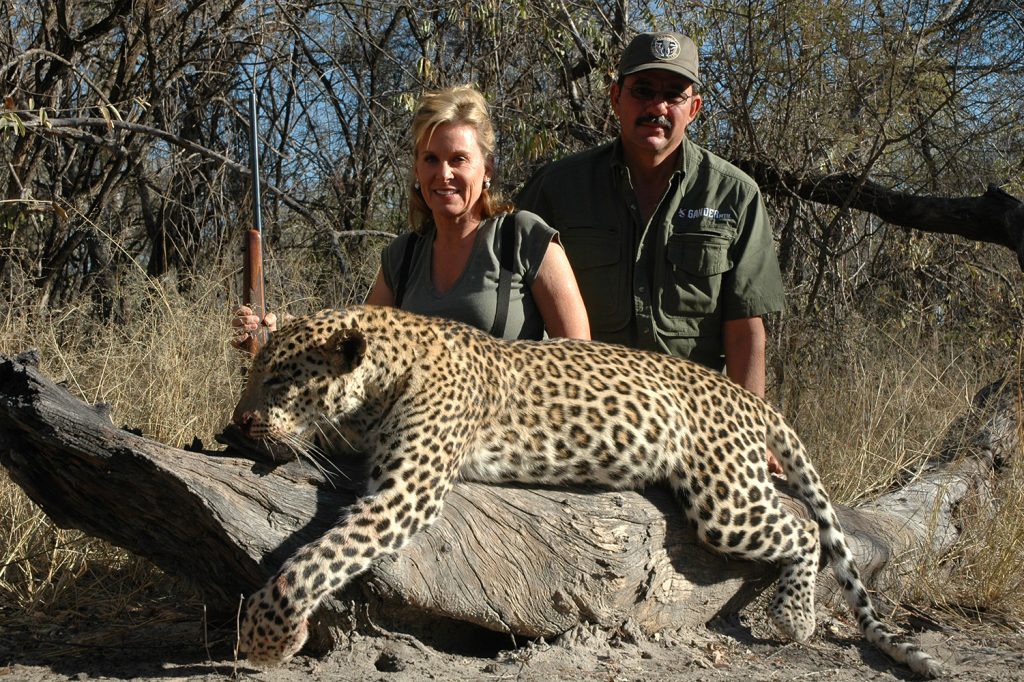
I love the .30-06, but I won’t pick favorites. Suitable choices run to many dozens! In some countries, 6.5mm is the legal minimum. A Creedmoor or 6.5×55 is plenty of gun, and a .270 Winchester is awesome. Harry Selby once wrote me: “Of the 103 leopards taken by my clients in East Africa, the majority were shot with my .243.” I’m not recommending a 6mm for leopard, but Selby’s rifle was well-scoped, and its accuracy and light recoil improved shot placement.
The great advantage of lighter, faster cartridges: Bullets designed to expand in deer-sized game. If local rules require a .375, consider a light bullet that can be pushed faster: The old 235-grain Speer, Hornady’s 250-grain, Nosler’s 260-grain. And, by all means, put a real scope on the rifle. You don’t need much magnification, but the brightness of a larger objective can be critical, and a lighted reticle speeds aim.
Unabashedly, I am a “big bore” guy, and leopards are dangerous. There are compromises. My first leopard, taken in 1985, is the only leopard I’ve effectively “dropped in its tracks.” The leopard was standing on the ground, and I shot it with a .338 Winchester Magnum with a fast 210-grain Nosler Partition. Quartering to, the bullet entered the on-shoulder and exited the off-hip. The leopard was down so fast I had no idea what happened. This past year, buddy John Stucker, hunting with Dirk de Bod, dropped his leopard under the tree, a feat I have not accomplished. He was shooting Dirk’s .338, loaded with the same fast, light-for-caliber 210-grain Partition. Perhaps just coincidental that both cats dropped to the shot, but the .338 does combine significant velocity with overwhelming power for leopard-sized game.
My most recent leopard hunts have been unsuccessful (part of the deal). I’d still like to take just one more. I don’t want to use the .243, love the .30-06 (also the .338), but I’d like to take my last leopard with a 7×57. If it was enough gun for Jim Corbett, it’s enough for me–and for any leopard that walks.
